
The Financial District of Lower Manhattan, also known as FiDi, is a neighborhood located on the southern tip of Manhattan island in New York City. It is bounded by the West Side Highway on the west, Chambers Street and City Hall Park on the north, Brooklyn Bridge on the northeast, the East River to the southeast, and South Ferry and the Battery on the south.

Richard Thurmond Chatham, who usually went by Thurmond Chatham, was a member of the U.S. House of Representatives, an industrialist and philanthropist. He represented North Carolina from 1949 to 1957.

In the law regulating historic districts in the United States, a contributing property or contributing resource is any building, object, or structure which adds to the historical integrity or architectural qualities that make the historic district significant. Government agencies, at the state, national, and local level in the United States, have differing definitions of what constitutes a contributing property but there are common characteristics. Local laws often regulate the changes that can be made to contributing structures within designated historic districts. The first local ordinances dealing with the alteration of buildings within historic districts was passed in Charleston, South Carolina in 1931.

The Immaculata Seminary Historic District, commonly known as Tenley Campus, is an 8.2-acre (3.3 ha) parcel of land, located off of Tenley Circle in the Northwest Washington, D.C. neighborhood of Tenleytown. The site of Dunblane, an early to mid-nineteenth-century Federal/Greek Revival-style manor house, it was once part of a large country estate on the outskirts of the capital city, owned by a succession of prominent Georgetown residents. From 1904 to 1906, the land was acquired by the Catholic Sisters of Providence of Saint Mary-of-the-Woods, who, for decades, operated all-girls primary, secondary, and postsecondary schools there under the Immaculata name, before being forced to shutter due to financial issues. Since 1986, it has been a satellite campus of American University, which purchased the site in part because of its proximity to Tenleytown station on the Red Line of the Washington Metro. It currently houses the school's Washington College of Law.

The South Street Station is an historic electrical power generation station at 360 Eddy Street in Providence, Rhode Island. The structure has since been redeveloped and is now used as an administrative office and academic facility by a number of local universities.
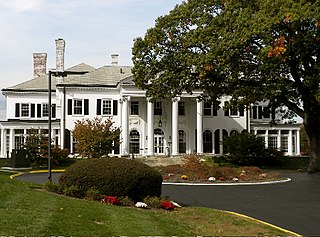
The Prospect Hill Historic District is an irregularly-shaped 185-acre (75 ha) historic district in New Haven, Connecticut. The district encompasses most of the residential portion of the Prospect Hill neighborhood.

The Whitney Avenue Historic District is a historic district in the East Rock neighborhood of New Haven, Connecticut. It is a 203-acre (82 ha) district which included 1,084 contributing buildings when it was listed on the National Register of Historic Places in 1989.
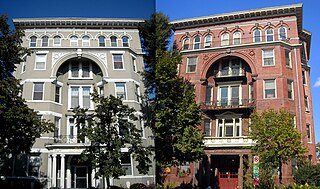
The Gladstone and Hawarden Apartment Buildings are historic twin buildings located in the Logan Circle neighborhood of Washington, D.C. Built in 1900 and 1901, the Gladstone and Hawarden are early examples of middle class apartment buildings in the city. They were designed in the Romanesque Revival architectural style by prominent local architect George S. Cooper. The buildings, since converted into condominiums and a housing cooperative, were added to the National Register of Historic Places (NRHP) in 1994.
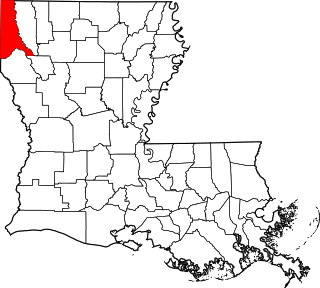
This is a list of the National Register of Historic Places listings in Caddo Parish, Louisiana.

The Sulgrave Club is a private women's club located at 1801 Massachusetts Avenue NW on the east side of Dupont Circle in Washington, D.C. The clubhouse is the former Beaux-Arts mansion on Embassy Row built for Herbert and Martha Blow Wadsworth and designed by noted architect George Cary. During World War I the Wadsworth House was used as the local headquarters for the American Red Cross.

Holt House is an historic house, located on the grounds of the National Zoo in Washington, D.C. Thought to have been built before 1814, it is one of the most important examples of early Neoclassical architecture in the city, and was one of the major houses in the new Federal City when it was built. Its caretaker has been the Smithsonian Institution since 1889, and is the oldest building under the Smithsonian's auspices, but has been left vacant since the 1980s. It was listed in the District of Columbia Inventory of Historic Sites in 1964 and was placed on the National Register of Historic Places on April 24, 1973.
Holt House has a long history of being in a bad state of repair. Its present condition is bad, and it was in a deteriorated condition when purchased by the Smithsonian in 1890.

The Awbury Historic District is a historic area in the East Germantown neighborhood of Philadelphia, Pennsylvania. It encompasses the former summer homes and farms of the extended Cope family, who moved to the area starting in 1849 and the entire Awbury Arboretum, which occupies most of the district's area, as well as adjacent properties developed and occupied by Henry Cope (1793-1865), son and successor to prominent Philadelphia Orthodox Quaker merchant Thomas Pym Cope (1768-1854), his close relatives, and his descendants. The district, which has been described by Philadelphia area historians as "visually distinct from the densely-built urban blocks that surround it on three sides, and from the level, open landscape of the city park to the northwest," features buildings which were designed in the Gothic Revival, Italian Villa, Queen Anne, Tudor Revival, Shingle, and Colonial Revival styles of architecture between 1849 and 1922.

Mount Zion Cemetery/Female Union Band Society Cemetery is a historic cemetery located at 27th Street NW and Mill Road NW in the Georgetown neighborhood of Washington, D.C., in the United States. The cemetery is actually two adjoining burial grounds: the Mount Zion Cemetery and Female Union Band Society Cemetery. Together these cemeteries occupy approximately three and a half acres of land. The property fronts Mill Road NW and overlooks Rock Creek Park to the rear. Mount Zion Cemetery, positioned to the East, is approximately 67,300 square feet in area; the Female Union Band Cemetery, situated to the West, contains approximately 66,500 square feet. Mount Zion Cemetery, founded in 1808 as The Old Methodist Burial Ground, was leased property later sold to Mount Zion United Methodist Church. Although the cemetery buried both White and Black persons since its inception, it served an almost exclusively African American population after 1849. In 1842, the Female Union Band Society purchased the western lot to establish a secular burying ground for African Americans. Both cemeteries were abandoned by 1950.
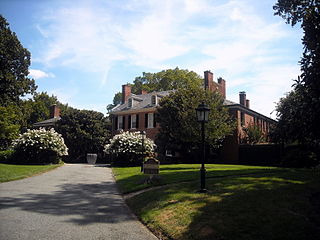
Evermay is a historic Federal architecture-style house at 1623 28th Street, Northwest, Washington, D.C., in the Georgetown neighborhood. The property originally extended south to Q Street, but the other houses were divided from the property.

Quality Hill, also known as the John Thomson Mason House, is a historic building, located at 3425 Prospect Street, Northwest, Washington, D.C., in the Georgetown neighborhood.
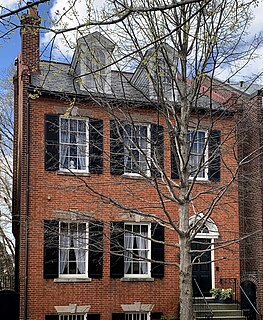
Isaac Owens House, also known as the Gannt-Williams House or John Walker House, is a historic building located at 2806 N Street NW Washington, D.C., in the Georgetown neighborhood.
Esenwein & Johnnson was an architectural firm of Buffalo, New York.
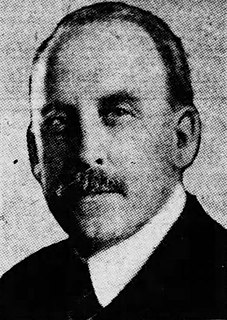
Albert L. Harris was an American architect who worked primarily in Washington, D.C. He was born in Wales and emigrated to the United States as a young child. He worked for architectural firms in Chicago and Baltimore and then Washington, where he also obtained an architectural degree from George Washington University. He was a part-time professor there while also working for the US Navy and then the city of Washington where he served as the city's Municipal Architect from 1921 until his death in 1933. A number of his works are listed on the National Register of Historic Places (NRHP).

The Georgetown Car Barn, historically known as the Capital Traction Company Union Station, is a building in the Georgetown neighborhood of Washington, D.C., in the United States. Designed by the architect Waddy Butler Wood, it was built between 1895 and 1897 by the Capital Traction Company as a union terminal for several Washington and Virginia streetcar lines. The adjacent Exorcist steps, later named after their appearance in William Friedkin's 1973 horror film The Exorcist, were built during the initial construction to connect M Street with Prospect Street.



















